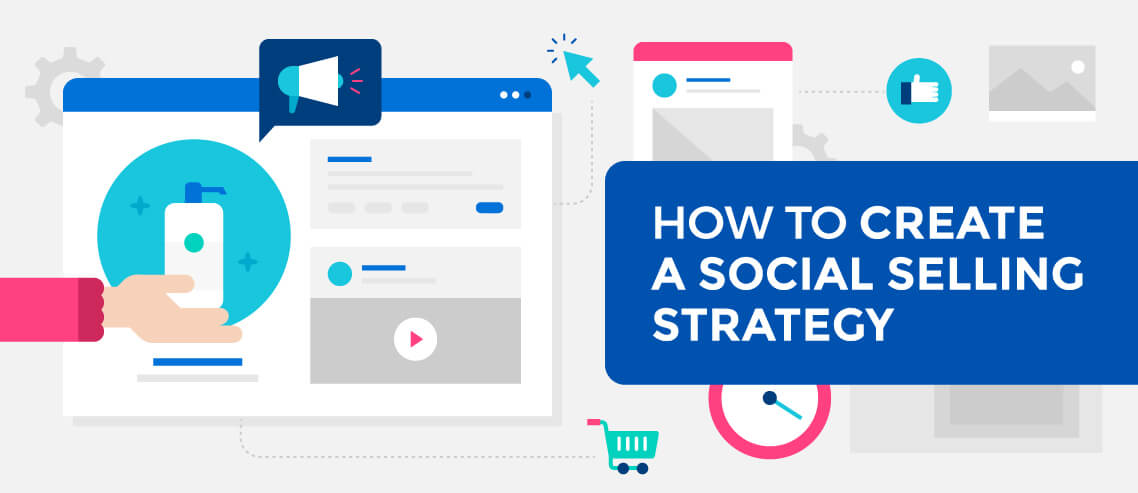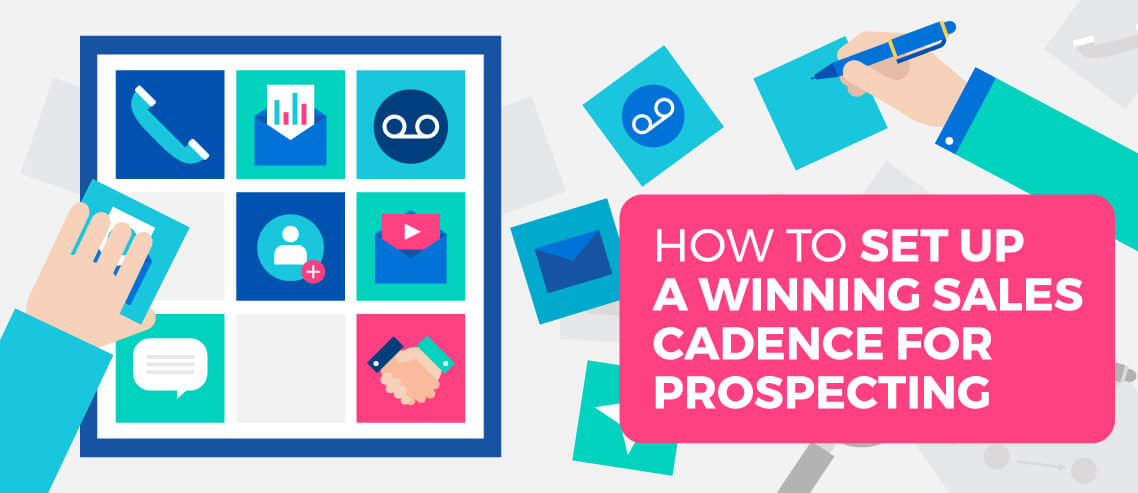How to Create a Social Selling Strategy

Contents
Social media can be a salesperson’s best friend. According to LinkedIn, reps who excel at social selling:
- Generate 45% more sales opportunities
- Are 51% more likely to hit quota
However, social media isn’t a silver bullet for salespeople — you can’t just start using it and hope to see results.
Instead, it requires proper planning and a detailed social selling strategy. Here’s how to develop yours.
What Is Social Selling?
Social selling is all about utilizing your social presence and connections to:
- Identify better prospects
- Build stronger relationships
- Hit your sales goals
By taking the time to engage prospects on sites like LinkedIn and Twitter, social selling supplements and supercharges traditional cold call and cold email activities. Now, when you pick up the phone or send an email to a prospect, they should already know who you are – and you should already have some understanding of their pain points, and whether they have a genuine need for your product.
So, to implement social selling effectively, you need to engage your audience. That means building relationships and waiting for the right moment to strike up a conversation, so that you can position yourself as an expert with a solution.
Many salespeople fail to master this point. Rather than offering advice and presenting a solution, they instead fall into the typical cold calling habit of spamming people they don’t know with hard sales pitches.
If you’re doing social selling well, you should never be irritating your prospects; they should genuinely welcome your input, because you’re offering something of real value.
Why Is Social Selling So Effective?
 I’ve already shared a couple of statistics that speak to the effectiveness of social selling. Here’s another: 78% of social sellers outsell peers who don’t use social media.
I’ve already shared a couple of statistics that speak to the effectiveness of social selling. Here’s another: 78% of social sellers outsell peers who don’t use social media.
Clearly, it can be an effective tactic when used properly. Here are three reasons why it works so well.
1. Building Stronger Relationships
If you’re prepared to do your research, you’ll find that prospects are happy to share a wealth of information to their network – things like their wants, needs, goals, and challenges.
As a salesperson, that gives you the opportunity to build up a partial picture of your prospect before you’ve ever reached out to them. Even your first point of contact with them can be personalized to some degree, which means that you’re more likely to come across as helpful and informed, rather than pushy and annoying.
The more time you put into social selling, the more effective it becomes. Why? Because when you have a strong network full of people who understand the value you bring, it’s easier to reach out to new prospects through your shared connections.
What’s more, those mutual connections are more likely to vouch for you, which builds trust and strengthens relationships with new prospects.
2. Connecting With Buyers on “Home Turf”
Salespeople aren’t the only ones leveraging the benefits of social media; buyers are doing it too.
That’s right: your prospects are actively looking for solutions on social. They’re speaking to their network and performing searches to:
- Discover solutions to their business challenges
- Learn about the vendors that offer those solutions
- Form an opinion about which vendor is the right fit for their needs
So if you’re not on social media, or aren’t using social as part of your sales strategy, you’re potentially missing out on all that low-hanging fruit.
3. Taking a Seat at the Table
As you likely already know, social selling isn’t the “next big thing” in sales – it’s already here, and it has been for years.
In fact, nine in ten top-performing salespeople say social platforms play a key role in closing deals and are an essential part of their sales strategy.
If the vast majority of top sales performers are utilizing social selling, you simply can’t afford to overlook it.
What Are the Best Social Selling Techniques?
By now, it should be clear that social media can add real value to your sales process.
But how does it work in practice?
Here are three broad techniques to help salespeople leverage the power of social.
1. Become a Thought Leader
Of the top five channels for which brands create content, four are social platforms.
Sharing content on social media helps position you as a thought leader: an authoritative, useful, relevant voice offering advice and information that benefits your audience.
Clearly, becoming a thought leader requires more effort than simply publishing a handful of LinkedIn posts. It requires commitment over an extended period.
So is it worth all the effort? Evidence suggests that yes, it is.
In a survey of decision makers, marketers, and sales professionals, more than half of respondents said they consider thought leadership content when deciding which organizations to work with, while a similar proportion said they read one or more hours of thought leadership content per week.
The same study revealed the effectiveness of thought leadership in drawing the eyes of the most valuable decision makers, with almost half of C-suite executives saying they have shared their contact details after reading thought leadership. Three-fifths also said they would be prepared to pay a premium to work with brands that create thought leadership content underpinned by a clear vision.
Yet it would appear that salespeople don’t fully recognize its value, as only two-fifths said they believe thought leadership content supports lead generation.
2. Connect With Prospects
 As obvious as it might sound, social media sites are designed for networking.
As obvious as it might sound, social media sites are designed for networking.
But networking as a salesperson can be difficult. When prospects see your job title, they often get defensive, fearing an imminent sales pitch or invasive questions.
The previous point about becoming a thought leader can help you network more effectively.
Once you’ve enhanced your personal brand and demonstrated that you’re a genuine expert in your field, not just a salesperson, prospects will be happier to connect with you. They may have already seen your content, or noticed your involvement in conversations with other people in their network.
They understand that you have something of value to say, which makes them more inclined to listen.
Again, this approach is backed by evidence. Two-thirds of salespeople who use social selling fill their pipelines, compared to under half of reps who don’t use it.
3. Understand Prospects Through Social Listening
Social listening is typically used to understand the popularity of a product or brand by analyzing comments on social networks, blogs, forums, and other platforms.
From a sales perspective, social listening is more about researching the types of conversations that your current and potential customers are having.
Done well, social listening can be highly impactful, allowing you to better understand buying signals and intent.
But it can also feel like an overwhelming task. With so many conversations going on, how do you separate the key information from the noise?
As a starting point, Sprout Social recommends looking out for the following types of terminology:
- Help-specific terms: Words like “help,” “recommend,” “tips,” and “ideas,” indicate that a prospect is looking for answers that could guide them toward a sale.
- Industry terms: Terms that are specific to your industry or product demonstrate a level of awareness that suggests some degree of buying intent.
- Location-specific terms: If your business serves a specific geography, like a city, state, or region, looking out for references to your location may help you discover buyers in your area.
- Transactional terms: Words like “sale,” “price,” and “cost,” suggest that a prospect is ready to buy but has a specific budgetary concern.
- Brand mentions: It pays to know when prospects are specifically discussing your brand. This could be a good point to jump into the conversation and provide answers.
How Does Social Selling Fit Into the Sales Process?
As with any sales activity, social selling doesn’t work in isolation. It must be part of a broader, unified strategy, alongside cold calling and cold email outreach.
Many sales teams fall down because they expect immediate results. When a single cold call could lead to a product demo and a sale, it can be hard to justify spending a chunk of time on social activities that don’t directly lead to sales-related conversations.
But while it takes time to build a strong personal brand on social platforms and grow your network, it can be achieved sooner than you might think.
Social selling expert Ben Martin insists that an effective social selling approach can be built by committing just one hour a day and following this 12-step process:
- Find content to share
- Share it to your social networks
- Check who’s viewed your LinkedIn profile
- Send a connection request to potential buyers who viewed your profile
- Look at who liked or commented on your posts
- Send connection requests to people who engaged with your content
- Review your LinkedIn alerts for things like job changes
- Segment your hottest leads into a dedicated list or folder
- Share weekly content with those “hot” prospects to further strengthen the relationship
- Review alerts from other social platforms, if relevant
- Respond to any outstanding direct messages on LinkedIn
- Start five or more new conversations with connections on LinkedIn
Keep doing this for 30 to 60 minutes a day, and your social selling strategy will start to yield results that benefit your whole sales process.
How Does Social Selling Work Across Different Platforms?
 There is no one-size-fits-all approach to social selling. People use different platforms in different ways. Your tactics must be flexible and tailored to the specific environment and prospect.
There is no one-size-fits-all approach to social selling. People use different platforms in different ways. Your tactics must be flexible and tailored to the specific environment and prospect.
With that in mind, here’s some practical guidance to social selling on key platforms.
1. LinkedIn
LinkedIn is the number one platform for B2B social selling, with 50% of B2B buyers using it as a source for making purchase decisions. In short, if you only have limited bandwidth for social selling, LinkedIn should definitely be your platform of choice. Make the right impression by following these steps.
Step 1: Build Credibility
Social selling should never feel like cold outreach; your prospects should already feel that they can trust you.
Word of mouth can go a long way to helping you achieve this. Do you have a good relationship with an existing client? Ask them for an endorsement or recommendation. These appear on your profile, building your authority with new connections.
One important point here: make sure that the skills you’re being endorsed for are relevant to potential customers, rather than future employers. A prospect likely doesn’t care that you’re experienced at using a specific CRM product (unless that’s the product you’re selling), whereas an employer might.
Step 2: Discover Connections
LinkedIn offers multiple ways to identify potential connections – people who might benefit from your product.
The most obvious way is to use the platform’s search functionality. Search for skills, job titles, companies, or industries that correlate with your buyer personas, and look out for people with whom you have shared connections. That way, you can use your existing relationship to send a connection request and strike up a conversation.
You should also keep an eye on your competitors. Who are their sales reps speaking to? Chances are, those people could also be a good fit for your product.
Step 3: Join Groups
Expand your network by joining LinkedIn Groups that are relevant to your industry. This gives you an opportunity to get involved in conversations and demonstrate your expertise.
To find relevant groups, either use the search functionality and select “Groups” on the results page, or browse LinkedIn’s tailored suggestions by:
- Clicking the “Groups” button in the left-hand menu on your LinkedIn homepage
- Scrolling to the bottom of your list of current groups
- Hitting the option that reads, “Search other trusted communities that share and support your goals”
2. Twitter
While it’s not quite as powerful as LinkedIn, Twitter can still be a useful weapon in a B2B salesperson’s arsenal. In particular, the Twitter Lists feature allows you to keep tabs on content from specific accounts or groups of people, which makes it great for social listening. Here are three steps to using Twitter lists to support your sales strategy.
Step 1: Search for Prospects
When you identify new prospects, search for their Twitter account and add them to a private list. That way:
- Competitors can’t see who you’re targeting
- The people on the list don’t know you’ve picked them out as prospects
Monitor the content posted by people on your private list and engage where appropriate, but don’t be over-familiar – remember, you don’t have an existing relationship with them. In particular, watch out for comments related to pain points that you can help with.
Step 2: Network With Existing Customers
Unless you’ve signed a non-disclosure agreement or are in a highly secretive industry, you can add existing customers to a public list. That way, prospects can view it to better understand the types of brands you already work with.
Engage with your existing customers in a meaningful way. Don’t just like their tweets for the sake of it; comment when you can add real value.
Step 3: Keep Tabs on Competitors
Monitoring what your competitors are doing can provide inspiration for your own social selling strategy. For instance, perhaps they’re sharing a particularly informative piece of content, or targeting a certain type of prospect. And perhaps you could be doing the same thing.
As with step #1, make sure you add competitors to a private list. That way, you can easily analyze their activity without them knowing you’re watching.
3. Other Platforms
Clearly, there are a lot of other social platforms out there. We haven’t even mentioned Facebook, which has almost ten times as many users as LinkedIn.
However, generally speaking, sites like Facebook, Instagram, and Reddit aren’t a great fit for social sales. People tend to be less willing to talk business on those platforms, because they’re more about connecting with friends and family.
If you are going to use them, you must position yourself as an authentic contributor to a community. That means not selling directly. Use them to expand your network, then connect with prospects via a different platform – most likely LinkedIn – when you’re ready to talk business.
5 Social Selling Tools You Should Be Using
A sales rep’s time is precious. And while social selling is a valuable tactic, you likely don’t want to spend all day on LinkedIn chatting to potential customers.
Fortunately, there are lots of tools you can use to remove much of the legwork from social selling. Here are five to consider.
1. LinkedIn Sales Navigator
The most famous social selling tool, from the most famous social selling platform. Sales Navigator is all about finding companies that might benefit from your product, as well as the key contacts at those companies with whom you should connect. Target accounts and leads can then be added to your CRM with a single click. If you only have budget for one social selling tool, make it Sales Navigator.
2. Hootsuite
Social selling relies on building and engaging a network of prospects, potentially on multiple social platforms. But staying on top of all those platforms can be confusing and inefficient. That’s where Hootsuite comes in. It allows you to manage all your platforms in one place, post or schedule content, and track performance metrics to see which tactics are generating the most engagement.
3. Nimble
Nimble is capable of automatically merging a wide range of information – from contacts and social connections, to communications and calendar appointments – from more than 160 apps and CRMs into a single relationship management platform. That makes it easier to track your various engagements with each prospect as your relationship with them progresses.
4. Meltwater
A media monitoring and business intelligence tool, Meltwater makes social listening easy. Dive into billions of social conversations on any topic you can think of, with data that extends back over more than a year, to better understand audience behavior and gauge sentiment toward your brand and competitors. Then save key searches so you can come back to them in future.





